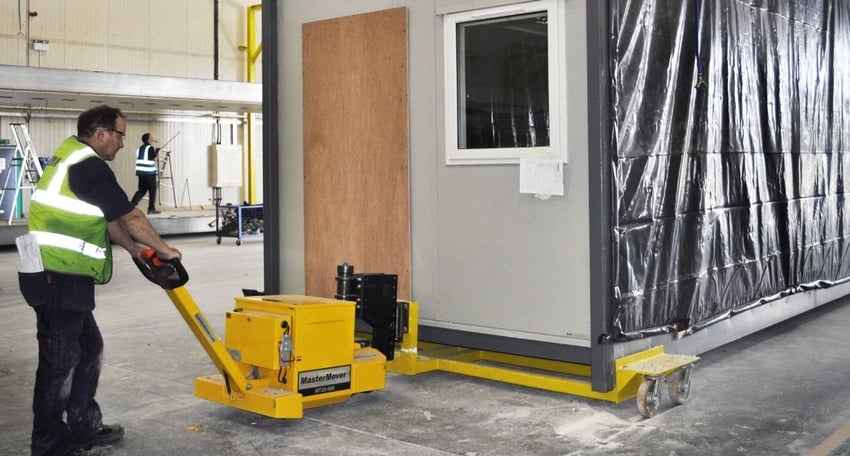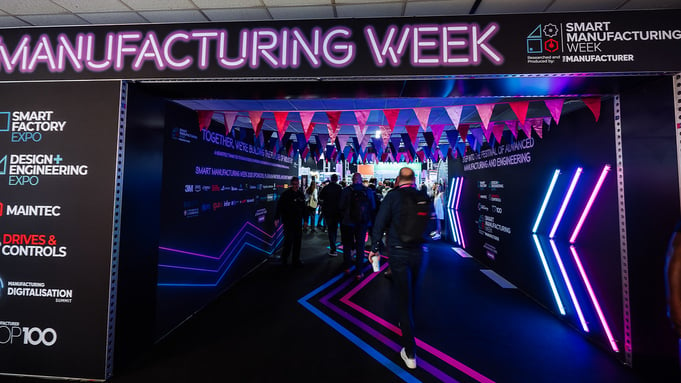Power Tugger Improves Production Efficiency And Throughput For Portable Buildings Manufacturer

By investing in two electric-operated pedestrian tugs, a UK-based manufacturer of modular, portable buildings has been able to improve its production flow and throughput, whilst also freeing up labour resources to focus on more value-added activities.
In addition, by using the MasterMover MT20 tugs rather than forklift trucks to manoeuvre the 6-8 tonne portable buildings around the factory floor, the company has significantly reduced the risk of workplace accidents and injuries to its employees. The tugs are also playing a vital role in supporting the plant’s recent change to a cellular manufacturing approach, by moving supply carts around the production areas, delivering materials and components to manufacturing cells.
The manufacturer is the UK’s largest provider of rental accommodation facilities and operates the largest fleet of rental accommodation facilities in the world.
The manufacturer’s UK assembly plant produces between 20 and 30 modular buildings each week. The buildings, which are delivered and installed nationwide to the public and private sectors, are used by customers as school classrooms, training facilities, temporary offices, health centres, REBs (relocatable equipment buildings) and nurseries.
Charles Harrison, Export Development Manager at MasterMover Ltd commented: “At the end of 2008, the customer changed its manufacturing approach to cellular manufacturing rather than flow line. This highlighted a potential problem at the factory with regard to the methods the company had been using to manoeuvre portable buildings through its production.”
Prior to investing in the MasterMover electric tugs, the manufacturer was moving each building through its factory using two forklift trucks, one positioned at each end of the building. One truck would then move forwards whilst the other reversed.
Typically, a modular building is 12 metres long by 3 metres wide and weighs between 6 and 8 tonnes. In order to move this structure through its production process, the company required at least a 4-tonne forklift truck on each end. The buildings would be moved in this manner through each stage of the manufacturing and assembly process, right through to despatch. This equated to a distance of around 250 metres from beginning to end of the process.
As well as being too slow and cumbersome, this method also carried with it an unacceptable level of risk of injuries or accidents to employees. Also, because the forklift trucks were not designed to transport the buildings around the factory, there was always a danger that a driver might lose control and cause a building to topple over, which could result in costly damage to other machines or equipment within the factory.
Production efficiency and throughput were also an issue. The amount of labour required to help move the buildings around production areas was inefficient. Three people were required in total. As well as requiring a licensed driver for each forklift truck, another person was also needed to pace and guide them. Now, using the tugs, only two people are needed to move the same building through every part of the manufacturing process.
“Manoeuvring with forklift trucks also took too much time and was not versatile enough. The larger buildings tended to bow when they were lifted, which could result in damage to the inside of the structure. In 2009, the customer changed to a cellular manufacturing layout, in which the cells run parallel to the production line. At this time, the customer knew it had to look for a safer and better way of moving the portable buildings through its factory,” says Harrison.
At this point, the customer recognised that it needed some sort of electric tug solution, so began searching the Internet for a suitable supplier. After visiting MasterMover’s website and liking the photos and videos of the tugs at work, the company requested an on site demonstration.
Following a site visit by one of its engineers, MasterMover recommended its MT20/960 as best suited to the task. The MT20/960 can pull, push and steer wheeled loads up to 9,600 kg. Traction is critical in the movement of heavy loads and so the MT20 is designed to provide all the traction it requires by using a coupling system that transfers load weight to the drive wheel. The MT20 is also capable of rotating through 90 degrees either side of the payload, allowing the conveyance to turn on its axis and manoeuvre with ease. Secondary electromagnetic braking, emergency stop and programmable maximum speed are other key features of the tug.
For the couplings to be used effectively, the customer had to design some suitable twin axle wheels for the modular buildings, which the MT20 could then be coupled to. These axles are designed to swivel through 90 degrees, giving even more freedom of movement to the buildings during their path through the assembly process.
The customer trialled the two MT20 tugs for three days, by which time it felt the units had more than proven themselves. A building can now be moved easily and quickly into each manufacturing cell just off the main production line, making life so much easier and safer for employees.
The customer justified the investment in the two tugs based on the labour savings it would make by using two people rather than three, as well as the benefits the tugs would provide in terms of a safer working environment. In addition, since using the tugs, the customer has been able to increase its production throughput by around 20 per cent, which is partly due to its new cellular manufacturing approach, which the tugs are a fundamental part of.
The only other alternative the customer had to buying the tugs was to purchase a larger forklift truck that could carry each building on its own, but the cost of this was prohibitive (£85k to £100k).
As well as moving each modular building through the assembly process, the new tugs are also being used to move supply carts to the manufacturing cells. These carts deliver crucial materials and parts to each cell, including windows, doors, plasterboard, electrical and plumbing supplies.
As Harrison concluded: “The customer said that learning to use the MT20 was extremely easy. Initially, a MasterMover engineer trained four staff within one hour at site. These four staff were then able to train four more people. Within a week, everyone who needed to use the MT20 was fully trained and competent in using the tugs.”


